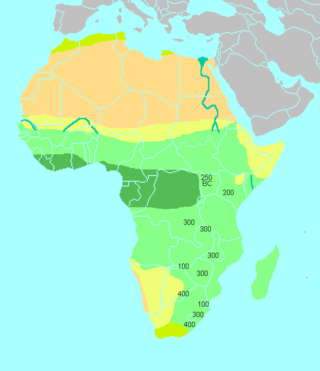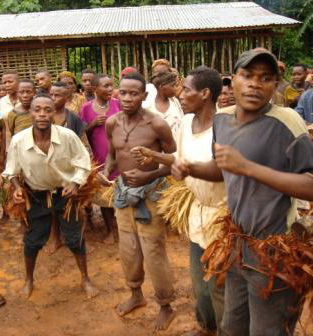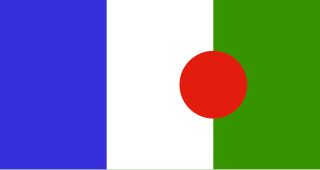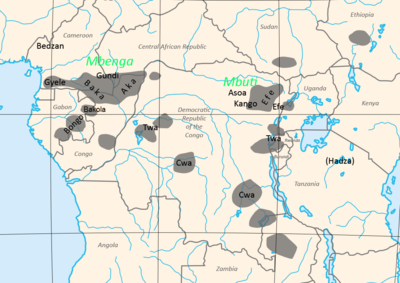
In anthropology, pygmy peoples are ethnic groups whose average height is unusually short. The term pygmyism is used to describe the phenotype of endemic short stature for populations in which adult men are on average less than 150 cm tall.

The Bantu expansion is a hypothesis about the history of the major series of migrations of the original Proto-Bantu-speaking group, which spread from an original nucleus around Central Africa. In the process, the Proto-Bantu-speaking settlers displaced, eliminated or absorbed pre-existing hunter-gatherer and pastoralist groups that they encountered.

Pygmy music refers to the sub-Saharan African music traditions of the Central African foragers, predominantly in the Congo, the Central African Republic and Cameroon.

The Mbuti people, or Bambuti, are one of several indigenous pygmy groups in the Congo region of Africa. Their languages are Central Sudanic languages and Bantu languages.

The Aka or Biaka are a nomadic Mbenga pygmy people. They live in south-western Central African Republic and in northern Republic of the Congo. They are related to the Baka people of Cameroon, Gabon, northern Congo, and southwestern Central African Republic.

The Baka people, known in the Congo as Bayaka, are an ethnic group inhabiting the southeastern rain forests of Cameroon, northern Republic of the Congo, northern Gabon, and southwestern Central African Republic. They are sometimes called a subgroup of the Twa, but the two peoples are not closely related. Likewise, the name "Baka" is sometimes mistakenly applied to other peoples of the area who, like the Baka and Twa, have been historically called pygmies, a term that is now considered derogatory.
The Gbaya languages, also known as Gbaya–Manza–Ngbaka, are a family of perhaps a dozen languages spoken mainly in the western Central African Republic and across the border in Cameroon, with one language (Ngbaka) in the Democratic Republic of the Congo, and several languages with few speakers in the Republic of the Congo. Many of the languages go by the ethnic name Gbaya, though the largest, with over a million speakers, is called Ngbaka, a name shared with the Ngbaka languages of the Ubangian family.
The Bongo people, also called Babongo or Bazimba, are an agricultural people of Gabon in equatorial Africa who are known as "forest people" due to their recent foraging economy.
Lese is a Central Sudanic language of northeastern Democratic Republic of the Congo, as well as a name for the people who speak this language. The Lese people, live in association with the Efé Pygmies and share their language, which is occasionally known as Lissi or Efe.
Aka, also known as Yaka or Beka, is a Bantu language spoken in the Central African Republic and Republic of Congo, along the Ubangi River dividing the two countries.

The Kwasio language, also known as Ngumba / Mvumbo, Bujeba, and Gyele / Kola, is a language of Cameroon, spoken in the south along the coast and at the border with Equatorial Guinea by some 70,000 members of the Ngumba, Kwasio, Gyele and Mabi peoples. Many authors view Kwasio and the Gyele/Kola language as distinct. In the Ethnologue, the languages therefore receive different codes: Kwasio has the ISO 639-3 code nmg, while Gyele has the code gyi. The Kwasio, Ngumba, and Mabi are village farmers; the Gyele are nomadic Pygmy hunter-gatherers living in the rain forest.
Baka is a dialect cluster of Ubangian languages spoken by the Baka Pygmies of Cameroon and Gabon. The people are ethnically close related to the Aka, collectively known as the Mbenga (Bambenga).However, the languages are not related, apart from some vocabulary dealing with the forest economy, which suggests the Aka may have shifted to Bantu, with an estimated 15000 people have shifted.
Bila, or Forest Bira, is a Bantu language spoken in the Mambasa Territory of the Democratic Republic of Congo. It is also spoken by the Mbuti Pygmies who live in that area. Pygmy groups to the west include the Kango and Sua (Batchua). Other Mbuti speak Central Sudanic languages. The Kango and Sua speak distinct dialects, but not enough to impair mutual intelligibility with their farming Bila patrons.

The Gyele, also known as the Kola (Bakola) or Koya (Bakoya), are the pygmies of southern Cameroon and adjacent areas of Gabon and Equatorial Guinea. They live among Bantu patrons, the Mvumbo and Bassa. They speak a variety of or a language closely related to Mvumbo.
The Kango (Bakango), also known as the Batchua and Mbuti-Sua, are an Mbuti pygmy people of the Ituri forest. They speak a Bantu language, Bila, apparently in two dialects, northern Sua and southern Kango.

The Twa are a group of indigenous Central African foragers tribes. These cultural groups were formerly called Pygmies by European writers, but the term is no longer preferred based on its cultural and geographic inaccuracy, as well as being seen as pejorative. Cultural groups are being reclassified by themselves based on their function in society, lineage, and land ties.

The 14,000 Twa of the swamp forest north and west of Lake Tumba and between Tumba and Lake Mai-Ndombe in the west of the Congo are one of several fishing and hunter-gatherer castes living in a patron–client relationship with farming Bantu peoples across central and southern Africa. In this case the people are the Mongo, specifically the Mongo tribes known as Ntomba, Lia (Bolia), and Konda. The two castes are called Oto and Twa: The Oto are the agricultural patrons of the Twa.

The Great Lakes Twa, also known as Batwa, Abatwa or Ge-Sera, are a Bantu ethnic group native to the African Great Lakes region on the border of Central and East Africa. As an indigenous pygmy people, the Twa are generally assumed to be the oldest surviving population of the Great Lakes region. Current populations of Great Lakes Twa people live in the states of Rwanda, Burundi, Uganda and the eastern portion of the Democratic Republic of Congo. In 2000 they numbered approximately 80,000 people, making them a significant minority group in these countries. The largest population of Twa is located in Burundi estimated in 2008 at 78,071 people.

The African Pygmies are a group of ethnicities native to Central Africa, mostly the Congo Basin, traditionally subsisting on a forager and hunter-gatherer lifestyle. They are divided into three roughly geographic groups:
The Bakoya are pygmies, earlier known as Négrilles or Babinga, who inhabitant the rainforest between Cameroon and the Great Lake region of the Congo Basin in Central Africa. Since the 1930s, the Bakoya, in particular, have settled in Gabon in the Ogooue-Ivindo Province, in the northeastern region of the country. Similar minority groups are the Babongo and the Baka pygmies. Before they adapted to the agricultural practices in the new settlements in Gabon along the flanks of the road, Bakoya were “semi-nomadic hunter-gatherers” like the other forest-dwelling pygmies; they resided in small huts. The word 'Pygmee' is a French coinage, adopted by the Gabonese. They are the earliest inhabitants of the forest and are nomadic hunter gatherers.












